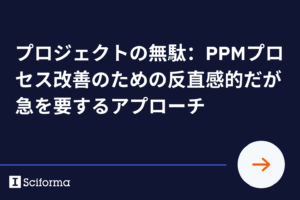- ホーム
- ブログ-Fidesio
- 付加価値のないタスクによるプロジェクトの無駄をなくす:一元化されたリポジトリの利点
付加価値のないタスクによるプロジェクトの無駄をなくす:一元化されたリポジトリの利点
In our previous post we discussed how most PMOs or project delivery organizations may be underestimating the amount of project waste. In fact, according to research published in Lean Office Innovation, 90% of all office work of any kind is non-value added and only 10% of work is value adding. So what is the solution?
The implication of this is that a given percentage increase in productivity for non-value-added tasks can have a much bigger impact on overall organizational productivity than the same percentage improvement in productivity for value-added tasks that represent only 10% of tasks performed. And if you focus only on the 10%, the simple math tells you that you a constrained to single-digit productivity improvements.
How did we get here?
Before discussing the solution to best address this process improvement opportunity, let’s quickly review the factors that got us here in the first place. The primary root causes of waste reduction challenges for most companies derive historically from 3 factors.
The first factor is not having a formal/centralized repository for project-related information. After all, a centralized repository helps facilitate and streamline searches for information like project templates, metrics, and financial data. Proving its importance, project team members frequently report spending over a day a week just searching for information in decentralized platforms like Excel.
Second, offline reporting processes including the manual collection, reconciliation and formatting of data for various reports and project reviews results in project team members spending on average a day a week preparing reports for status and project review meetings.
Third, a lack of automation of simple, high-volume tasks such as timesheet administration, project and task handoffs, and manual data entry have all been cited as key challenges leading to the purchase of project management software.
As a result of these factors, organizations experience an epidemic in lost productivity, unreliable reporting, and general project team frustration due to a lack of basic tools for executing basic project activities and tasks that deliver little or no value.
Solution Requirements
To minimize project waste, you will need some new processes and/or tools. There are three key components.
-
- Centralized Data and Knowledge Base. This is a centralized repository and proverbial “single version of truth” and system of record for project data and documents. Because all information exists in a single place, project waste associated with searching for information is virtually eliminated.
-
- Centralized Reports & Dashboards. Once you have your data centralized, it’s relatively straightforward to define and generate standard reports and dashboards. After all, reports are trustworthy since you can control access to the system, directly enter information, and the system calculates data roll-ups/aggregations.
-
- Simple Task/Workflow Automation. Basic project tracking functionality of most tools automates common non-value-added task like timesheet administration, task assignment communication, completion tracking and approvals, and associated alerts and notifications.
What a Successful PPM Solution Looks Like
If you were to implement such a solution you can expect that PMs and team members have up to 40% more time to complete value-added work. You will also find that business stakeholders and PMO leaders make project-related decisions with significantly increased confidence due to data reliability improvements. Finally, expect project team morale to reach an all-time high as teams feel supported with the processes and tools to maximize their impact and minimize grunt work.
Next Steps
You can build and integrate these components internally or adopt a PPM solution which integrates out-of-the-box a centralized data and knowledge repository, standard out-of-the-box reports, and task automation (value-add and non-value-added task). Check out the Sciforma eBook on eliminating project. It provides a more detailed description of the solution framework components and the steps to implementing them







Valerie Zeller
ValerieはSciformaの最高マーケティング責任者で、PPMソリューションがビジネスゴールの達成にどのように役立っているかをリサーチし、その情報を共有したいと願っています。 関心事:デジタルトランスフォーメーション、チェンジマネジメント、ストラテジーエグゼキューション コメントは@valeriezellerへ